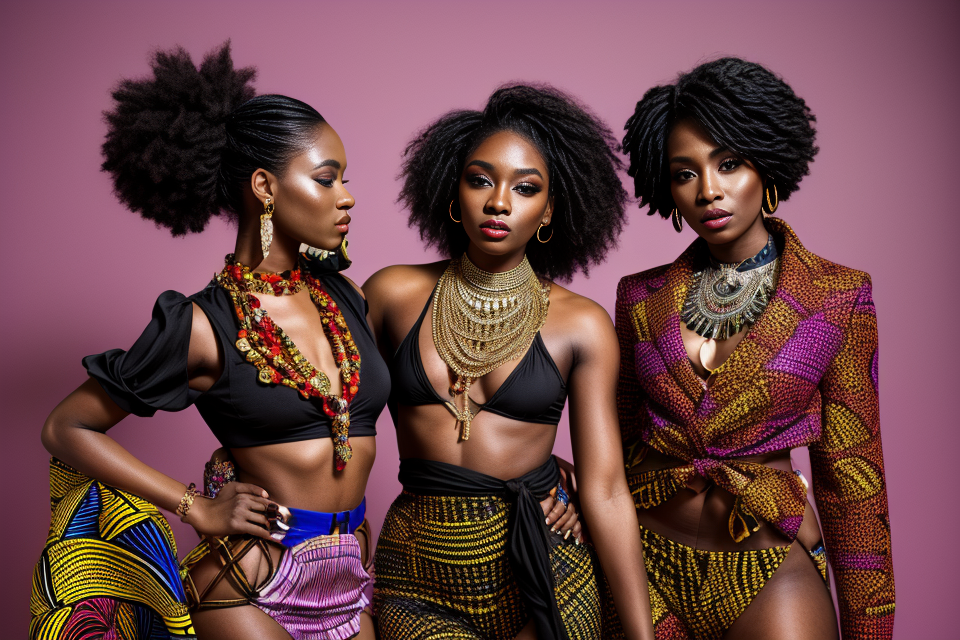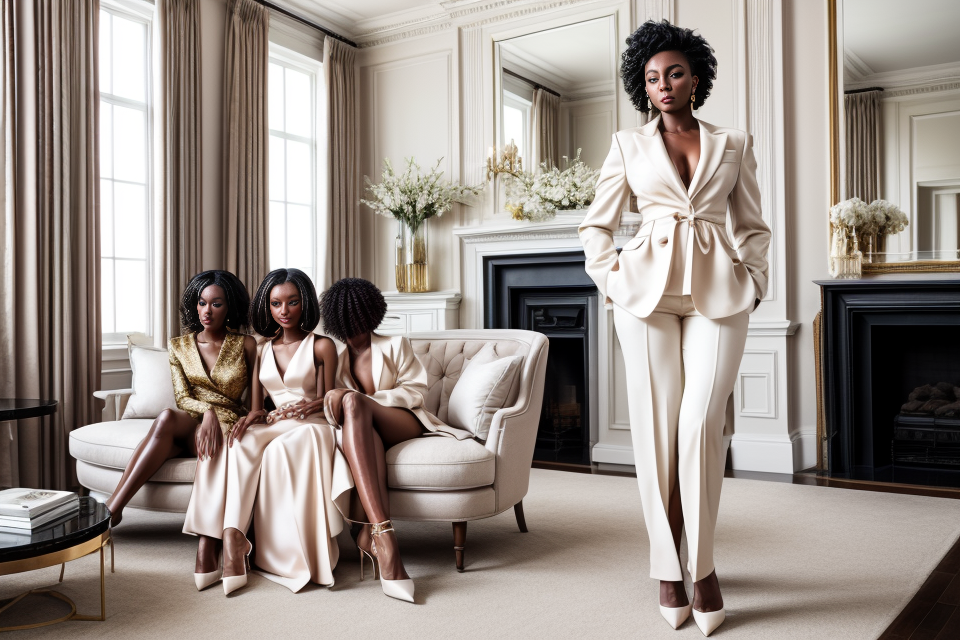The world of fashion has long been dominated by designers of European descent, with few people of color breaking through the barriers to achieve international recognition. However, the history of fashion would not be complete without acknowledging the contributions of the first black fashion designer, who defied the odds and blazed a trail for future generations. In this article, we will delve into the life and legacy of this pioneering figure, whose work and impact on the fashion industry continue to inspire and influence designers today. Get ready to discover the unsung legacy of the first black fashion designer, and the lasting impact they had on the world of fashion.
The Early Life and Education of Ann Lowe
Born into a Family of Seamstresses
Ann Lowe was born in 1898 in Montgomery, Alabama, into a family of seamstresses. Sewing was a skill passed down through generations in the Lowe family, and it played a crucial role in shaping Ann’s early life and eventual career as a fashion designer.
Sewing was not just a skill but a way of life for the Lowes. Ann’s grandmother, a freed slave, was a talented seamstress who taught the art to her daughter and granddaughter. Ann’s mother, also named Ann, was a seamstress who ran a dressmaking business out of their home. Ann grew up watching her mother create beautiful dresses and learned the craft at a young age.
The early influences that shaped Ann’s passion for fashion were not limited to her family. She was also inspired by the rich cultural history of African Americans in the South. The intricate quilts, patterns, and textiles created by enslaved people during the 19th century left a lasting impression on Ann. She admired the way these textiles told stories and reflected the culture and history of African Americans.
Ann’s love for fashion was further fueled by her desire to break free from the societal limitations placed on African American women during the Jim Crow era. She understood the power of fashion as a form of self-expression and used it as a means to challenge racial barriers.
As a young girl, Ann spent countless hours creating her own dresses and experimenting with fabrics and patterns. She honed her skills and developed a keen eye for detail, which would later become the hallmark of her designs. Her family’s legacy of sewing and her own passion for fashion set the stage for Ann’s future as a trailblazing black fashion designer.
Overcoming Racial Barriers in Education
Ann Lowe was born in 1898 in Montgomery, Alabama, during a time when racial segregation and discrimination were prevalent in the South. Despite facing numerous challenges, Ann was determined to pursue her passion for fashion and received her education.
In the early 20th century, black students in the South were denied access to the same educational opportunities as their white counterparts. Segregated schools were underfunded, and black students were often taught in overcrowded and dilapidated classrooms. Moreover, black teachers were not given the same respect or recognition as white teachers, which further hindered the quality of education for black students.
Ann Lowe faced these racial barriers head-on, as she was determined to receive a proper education and pursue her dream of becoming a fashion designer. She attended a small black school in Montgomery, where she was taught by a dedicated black teacher who recognized her talent and encouraged her to pursue her passion.
Despite the challenges, Ann persevered and graduated from the highest-ranking black school in the state. She then went on to attend the Tuskegee Institute, a historically black university in Alabama, where she studied design and became the first black student to be accepted into the school’s program.
Ann’s determination and resilience in the face of racial barriers and discrimination set the stage for her remarkable career as a fashion designer. Her unwavering dedication to her craft and her commitment to breaking down racial barriers in the fashion industry make her an inspiration to future generations.
The Evolution of Ann Lowe’s Fashion Career
The Birth of an Iconic Fashion Brand
In the early 1900s, Ann Lowe’s fashion career began to take off as she started her own fashion house. With a keen eye for detail and a deep understanding of the intricacies of design, Lowe quickly established herself as a force to be reckoned with in the world of fashion.
Her signature style was characterized by its timeless elegance and sophistication, and her designs were quickly sought after by society’s elite. Lowe’s attention to detail was unparalleled, and she was known for her use of high-quality materials and intricate embellishments that added a touch of glamour to every garment.
One of Lowe’s most notable achievements was her design for the wedding dress of Jacqueline Bouvier, which was worn during her marriage to John F. Kennedy. This iconic dress solidified Lowe’s reputation as a designer to the stars and cemented her place in the fashion industry.
Lowe’s fashion house continued to thrive throughout the mid-twentieth century, and her legacy lives on today as her designs continue to inspire new generations of fashion lovers. Despite facing numerous obstacles and challenges as a black woman in a predominantly white industry, Lowe’s impact on the world of fashion cannot be overstated.
Catering to the Elite
Ann Lowe’s clientele consisted primarily of high-society ladies and celebrities, a testament to her ability to cater to the elite. Her talent and dedication to her craft allowed her to gain a reputation as a go-to designer for the upper echelon of society.
Ann Lowe’s adaptability to changing fashion trends was another factor that contributed to her success in catering to the elite. She continuously updated her designs to stay current with the latest styles, ensuring that her clients always looked fashionable and chic. This adaptability was especially impressive given the limited resources and lack of recognition she faced as a Black designer in the industry.
Moreover, Ann Lowe’s attention to detail and commitment to quality were highly regarded by her clients. She used only the finest materials and meticulously crafted each piece, resulting in garments that were both elegant and timeless. Her designs were renowned for their beauty and sophistication, making her a favorite among the elite.
In addition to her work with high-society ladies, Ann Lowe also dressed numerous celebrities, including actresses and other notable figures. Her designs were often featured in films and on the red carpet, further solidifying her reputation as a premier fashion designer.
Overall, Ann Lowe’s ability to cater to the elite was a testament to her talent, dedication, and adaptability. Her success in this area helped to establish her as a leading figure in the fashion industry and paved the way for future Black designers.
Breaking Barriers in the Fashion Industry
Ann Lowe was a trailblazer in the fashion industry, breaking down barriers for black women in a field that was largely dominated by white men. Despite facing racism and sexism throughout her career, she remained determined to succeed and make her mark on the industry.
One of the biggest challenges that Ann Lowe faced was the lack of opportunities for black people in the fashion industry. At the time, most fashion design jobs were held by white people, and it was rare for a black person to be hired in a position of power. Despite this, Ann Lowe was able to carve out a successful career for herself, thanks to her talent and determination.
Another major obstacle that Ann Lowe faced was the discrimination she experienced as a black woman. In the 1920s and 1930s, when she was starting out in the fashion industry, racism was rampant in the United States. Many people believed that black people were inferior to white people, and this often manifested in the form of discrimination and prejudice. Ann Lowe faced this discrimination not only as a black person, but also as a woman, as the fashion industry was also largely dominated by men.
Despite these challenges, Ann Lowe was able to rise to the top of the fashion industry. She was known for her impeccable sense of style and her attention to detail, and her designs were highly sought after by celebrities and socialites. She also worked with some of the biggest names in the industry, including the fashion magazine Vogue and the designer Christian Dior.
Overall, Ann Lowe’s career was a testament to her strength and determination in the face of adversity. She was a true pioneer in the fashion industry, and her legacy continues to inspire future generations of designers.
The Legacy of Ann Lowe
The Influence of Ann Lowe on Contemporary Fashion
Despite facing numerous obstacles and prejudices during her time, Ann Lowe’s work has had a profound impact on contemporary fashion. Her unique approach to design and her mastery of craftsmanship have left a lasting legacy in the industry.
The impact of her designs on the fashion industry
Ann Lowe’s designs were characterized by their elegance, sophistication, and attention to detail. Her gowns were made from the finest fabrics and were intricately embellished with lace, beading, and other embellishments. Her work was renowned for its fit and its ability to flatter the female form. Her designs were favored by the wealthy and influential, and her client list included socialites, celebrities, and even members of the royal family.
How her work has influenced contemporary designers
Ann Lowe’s legacy has continued to influence contemporary fashion in a number of ways. Many contemporary designers have cited her as an inspiration, and her designs have been referenced in countless collections. Her use of intricate embellishments and her attention to detail have been particularly influential, and her designs have inspired many contemporary designers to experiment with embellishments and other decorative elements.
Furthermore, Ann Lowe’s perseverance and determination in the face of adversity have served as an inspiration to many in the industry. Her legacy reminds us of the importance of hard work, dedication, and creativity in achieving success in the fashion industry.
Recognition and Honors
Ann Lowe’s contributions to fashion have been recognized posthumously, with numerous awards and honors bestowed upon her legacy. These include:
- Induction into the Fashion Hall of Fame: In 2019, Ann Lowe was posthumously inducted into the Fashion Hall of Fame, recognizing her as a trailblazer in the fashion industry.
- The Couture Legacy Award: In 2018, the Black Fashion History Project awarded Ann Lowe with the Couture Legacy Award, honoring her for her pioneering work in the fashion industry.
- Google Doodle: In 2020, Google celebrated Ann Lowe’s birthday with a Doodle, recognizing her contributions to fashion and her significance as the first Black fashion designer.
- National Museum of African American History and Culture: Ann Lowe’s work is featured in the National Museum of African American History and Culture, cementing her place in history as a groundbreaking fashion designer.
These honors serve as a testament to Ann Lowe’s impact on the fashion industry and her role as a trailblazer for future generations of Black fashion designers.
Ann Lowe’s Continuing Influence on Black Fashion
Despite her relatively small body of work, Ann Lowe’s contributions to the world of fashion have had a lasting impact on the industry and continue to inspire designers of all backgrounds. Her unique style and attention to detail, combined with her dedication to creating beautiful and timeless pieces, have made her a role model for many young black designers.
The importance of her work for black women in the fashion industry
Ann Lowe’s work was particularly important for black women in the fashion industry, who were often excluded from mainstream fashion magazines and shows. By showcasing her designs in prominent venues, Lowe helped to challenge the prevailing stereotypes about black women and their place in the fashion world.
Through her work, Lowe also sought to create clothing that was both beautiful and practical, reflecting the real-world needs of her clients. She believed that fashion should be accessible to all women, regardless of their background or economic status, and her designs were characterized by their simplicity, elegance, and timelessness.
The legacy of Ann Lowe as a source of inspiration for future generations
For many young black designers, Ann Lowe’s story serves as a source of inspiration and motivation. Her success in a field that was often hostile to people of color demonstrates the power of hard work, determination, and creativity, and her designs continue to inspire new generations of fashion professionals.
Lowe’s legacy has also been embraced by the wider fashion community, which has come to recognize the important contributions of black designers to the industry. As a result, Ann Lowe’s influence on black fashion can be seen in the work of designers from all backgrounds, who have drawn inspiration from her unique style and approach to design.
In the end, Ann Lowe’s legacy as a pioneering black fashion designer is one that continues to inspire and motivate future generations of designers, reminding us of the power of creativity and determination to overcome even the most daunting obstacles.
FAQs
1. Who was the first black fashion designer?
The first black fashion designer is believed to be a man named William Ellis. He was born into slavery in the early 19th century and eventually gained his freedom. He went on to become a successful tailor and fashion designer, and his work was highly sought after by the wealthy elite of the time. He is often referred to as the “first black fashion designer” due to his pioneering work in the field.
2. When did William Ellis live?
William Ellis was born into slavery in the early 19th century, and he lived until around 1850. During his lifetime, he gained his freedom and went on to become a successful tailor and fashion designer.
3. Where did William Ellis work as a fashion designer?
William Ellis worked as a fashion designer in New York City. He was highly regarded for his skill and craftsmanship, and his work was in high demand among the wealthy elite of the city. He was also known for his work as a tailor, and he had a reputation for creating beautifully made garments.
4. What was William Ellis’s contribution to the fashion industry?
William Ellis was a pioneering figure in the fashion industry. He was the first black fashion designer, and his work helped to pave the way for future generations of black designers. He was also a talented tailor, and his attention to detail and craftsmanship helped to establish him as one of the leading fashion figures of his time.
5. Why is it important to recognize the legacy of William Ellis?
Recognizing the legacy of William Ellis is important because it helps to shed light on the contributions of black people to the fashion industry. For too long, the contributions of black designers have been overlooked and undervalued, and it is important to recognize and celebrate their achievements. William Ellis was a pioneering figure in the fashion industry, and his legacy should be remembered and celebrated.



